New Mexico is trapped between the “Great” Arizona, the “Friendship” Texas and south of the “Centennial” Colorado. New Mexico, one of the southwestern States is often left out by tourists visiting the western United States. It is a pity because New Mexico is total ! The motto of the state is even “Land of Enchantment” (or Tierra de Encato). It is a land of extremes and contrasts: a broad desert plateau surmounted by high mountains. This less-known State offers a variety of astonishing landscapes: rose colored deserts, high snow-capped peaks, broken mesas, meadows, forests and plateaus. Despite the arid image of New Mexico, the State pulls together a little of just about everything you can see in the United States. New Mexico, Arizona, Colorado and Utah meet at the Four Corners in the northwestern corner of New Mexico. The state offers a rich culture drawn from the different peoples who have fought on its territory… Mexicans, Spaniards, Indians and Native Americans have left behind architecture and traditions. As French journalist and novelist, Joseph Kessel wrote in his 1955 novel “The Valley of Rubies“: “Great voyages have the wonder that their enchantment begins before the departure. You open an atlas and begin to dream over the maps, rolling your tongue around the splendid names of towns you’ve never been to…” Tent Rocks, Santa Fe, Albuquerque, White Sands, Roswell… I just need to close my eyes and as if by magic, I am already there !
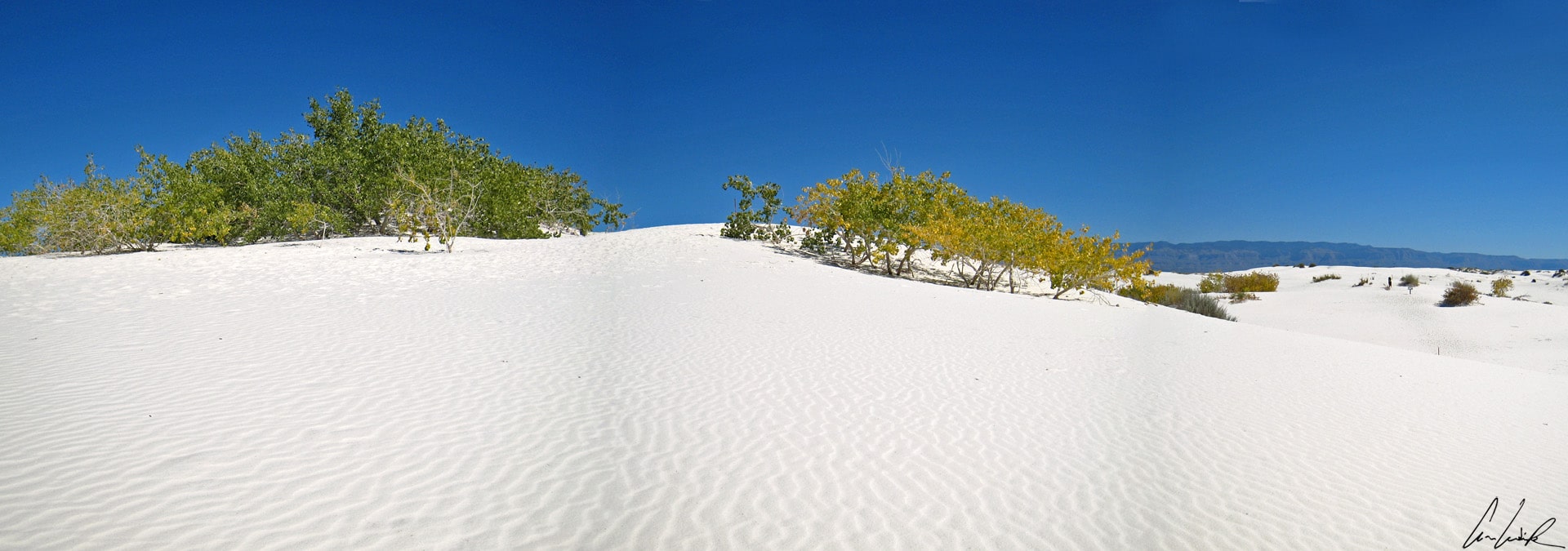
White Sands National Monument, gypsum dunes
The Tularosa Basin lies north of the Chihuahua desert between the Sacramento Mountains to the east and San Andres and Oscura Mountains to the west. It covers about 6,500 square miles, and at its center is a peculiar site, a field of white sand dunes. This natural wonder was designated a National Monument in 1933 by President Herbert Hoover. Formerly territory of the Mescalero Apaches, the White Sands National Monument has an interesting, if not surprising, feature: it is composed of gypsum crystals. It is the largest gypsum field of its kind on Earth. Looking like giant, sparkling white waves, the sparkling white gypsum dunes extend over 275 square miles. The sand, pushed by south-west winds, forms bright dunes that change constantly in shape: they grow, rise up and then lower, but always progressing inexorably… There are four forms of dunes: dome dunes, barchan dunes (crescent shaped), transverse dunes and the parabolic dunes. Whatever their shapes, these dunes are renewed indefinitely, they move tirelessly, and if they encounter the slightest obstacle on their path, they bury it or flow around it like water. Slowly, these billions of grains of sand cover everything in their path ! Mineral gypsum, which is soluble in water, is very rarely found in the form of sand. Unlike dunes made of quartz-based sand crystals, the gypsum does not convert the sun’s energy into heat. You can walk bare foot even during the hottest summer days. The Tularosa basin is an endorheic basin. No water flow out of it. It traps water and gypsum as well as the other sediment. Rain and snow falls on the surrounding mountains. The San Andres rise to 8,965 feet and the Sacramento to 9,695 feet above sea level. The water flows down dissolving the gypsum and leaving a deposit on the surface…

White Sands National Monument, Dunes Drive
Cruising along Dunes Drive, the only road that runs through the park, visitors from the visitor center to the east into the heart of the dunes to the west. The 8-mile scenic Dunes Drive is surrounded by a surreal landscape that looks as if the road has been freshly cleared by a snow plow. This dreamlike sensation is strengthened by the sight of joyful children and adults tirelessly sledding on the soft white dunes… sleds can be rented at the Visitor Center. We do not just look at the dunes, we “ride” them ! Hiking through the dunes is an excellent way to explore the splendor of the park and to find yourself alone in the immensity of white sand. The park includes many trails such as Playa Trail, Dune Life Trail, Alkali Flat Trail, allowing you to go up and down and then then up and down the dunes… you lose not only a sense of distance but also of time. The dunes encircle us like so many impenetrable barriers. We see the mountains in the background, sometimes a bush, sometimes a flower… The silence is total and yet a small wind from the west seems to blow words or tunes like Under the same sun by Scorpions, The End by Pink Floyd, Best Friend by Puff Daddy or Sara Evans’s I could not ask for more… The wind can easily, in just a few minutes cover your footsteps… If you lose yourself in this blue and white immensity, you may be rescued by a hero from a movie shooting in the area. Perhaps “Lucky Lucke” or “Optimus Prime“… But fortunately, the trails are well marked with sticks! However, exploring this moon-like landscape requires following a few safety tips, including bringing a lot of water. In this unique environment, severe weather (high heat, aridity) and ever-changing dunes (between a few inches and several feet per year), the flora and fauna have adapted to survive. As Albert Einstein said, “The only source of knowledge is experience”… Here, for example, lizards, locusts and mice have adopted a white camouflage ! The Rangers offer a sunset tour every evening to explain the nightlife of the park to visitors. The fauna is mostly active in the evening or at night. Hiking under the glow of the full moon is a chance to enjoy the peace and serenity of this magical environment and to experience what residents of the park, rabbit, deer, great roadrunner, rattlesnake, tarantula and fox, find in this environment. The flora is well-adapted to this arid environment: yuccas grow fast and are therefore able to survive the movement of the dunes while the “squawbush” or “skunkbush sumac” collects the sand around its roots so as to always remain always perched on a pedestal.

Kasha-Katuwe Tent Rocks National Monument
Change of scenery… another place, another landscape this time just 40 miles southwest of Santa Fe: the Kasha-Katuwe Tent Rocks National Monument. Kasha-Katuwe means “white cliffs” in the Pueblo language Keresan, which is still spoken in the Pueblo community of Cochiti. On the trail that leads to the site, the arid plateau abounds with many plants, cacti and flowers such as Fallugia paradoxa (Apache Plume), Castilleja (Indian paintbrush) and Polanisia dodecandra. All these colorful flowers have adapted to the arid environment. In this amazing profusion of colors we discover with wonder the Kasha-Katuwe Tent Rocks National Monument, one of the most beautiful places in the world. The site was established as a National Monument by President Bill Clinton in January 2001. The park is located on the Pajarito Plateau at 6,400 feet above sea level. The most prominent feature of this site is the presence of rock towers whose pointed tops resemble a tent. Hence the name “tent rocks”. The area owes its geological shape mainly to layers of volcanic rock and ash deposited by pyroclastic flow from a volcanic eruption in the Jemez volcanic field some 6 to 7 million years ago. Rocks and ashes overlap in a formation 985 feet thick. Over time weathering and erosion of these layers have created canyons, tent rocks, and slot canyons. The tent rocks are fairy chimneys of soft pumice and tuff, surmounted by lava caprocks.

Kasha-Katuwe Tent Rocks National Monument, hoodoos !
The 1.2 mile-Canyon Trail begins in a Slot Canyon and passes through a succession of narrow passages where striated rocks of various height create surreal landscapes. The cliff has different strata with shades of pink, white and sand. The canyon bends to the right and then to the left, giving no sign of what is hidden behind the next bend… Suddenly, there appears a field of hoodoos ! It looks like if a giant pastry chef made meringues, now forever solidified. Some chimneys have kept their mineral headdress, others have lost it thus forming pyramids. Continuing the trail, after a few minutes of climbing we reach a plateau offering a lookout point with a 360 degree panorama view over the mesas and pink and white cliffs. The Jemez Mountains stand in the distance. Enchanting !
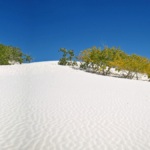
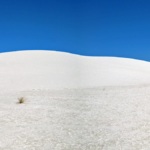

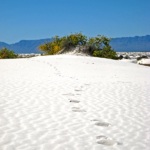
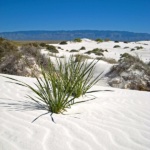
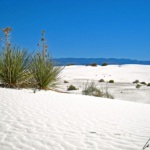
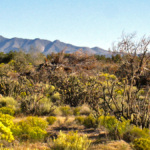
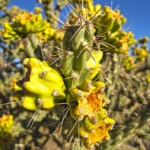




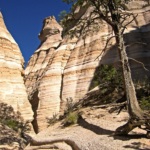
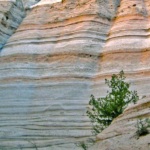
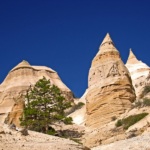
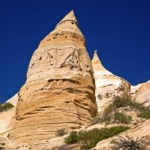
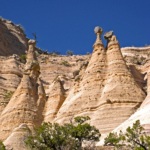
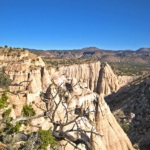


Thank you for showcasing one if my fav states! We visited NM in 2012 for the july 4 weekend and I so want to go back and see the white sands national monument!
The dazzling dunes of White Sands National Monument are a dreamscape for desert hikers ! Undulating endlessly towards distant mountains that shimmer on the horizon, they make an unearthly spectacle.
Great write up on a great state! I’m from Texas and make the regular roadtrip from here to Cali, and we always make sure that we make a stop in New Mexico! I absolutely LOVE the white sands and Santa Fe is a charm! Thanks for sharing!
Santa Fe is the heart of New Mexico’s culinary experimentation and the city has a lot to show for its 400-year history. Native American galleries, gourmet restaurants and cozy B&Bs, Santa Fe is a world apart.
What an enchanting place! The sand is so white that at first glance it seems snow! 😀
It’s true the state has magical desert vistas. And there is quite a lot of space to explore. You might be surprised by what you find 🙂
Indeed ENCHANTING!! Rose coloured deserts sound unique and interesting! After reading your detailed post would love to visit New Mexico Thanks
New Mexico offers travel experiences found no where else in the world ! Mother Nature has tucked away unexpected treasures, including undulating fields of white-sand dunes and enormous limestone caves set unassumingly underfoot. Colorful, varied regional vegetation gives a cinematic quality to the desert landscape. New Mexico is the perfect destination for outdoorsy travelers hoping to tap into the region’s enchanting landscapes !
I’d love to hike through those dunes! Interesting about the lack of heat retention too.
Out in the middle of nowhere near the Mexican border is the most magnificent pile of white gypsum I’ve ever seen. You’re free to go sand sledding down, explore, and even go backpacking through. The scenery there is surreal and magical !
I have always wanted to visit New Mexico, I can’t believe that people skip over it! Thanks for sharing some of the incredible things to see there!
New Mexico remains largely off the tourist radar When it comes to desert destinations in the United States. New Mexico’s scenery is spectacular, the parks accessible, and the crowds far and few between, even during a holiday weekend in summer 🙂
OMG I was really surprised when I saw the pictures because I’ve been to Cuatro Cienegas (northern Mexico) and they have exactly the same dunes there! O.o Probably because it’s the same natural area, Cuatro Cienegas is close to the border of New Mexico.
I had never thought about this state but it seems really interesting now that I’ve read your post. I hope I’ll be able to go there once!
I had a look at Cuatro Cienegas and I added this place to my bucket list. The only place I visited in Mexico so far is the beautiful city of Querétaro. I should definitively plan another trip there 😉
The white sand looks unbelievable! Land of enchantment indeed! I love how you described the hoodoos as giant meringue Great write up! ☺️
Thank you 🙂 White Sands National Monument is absolutely 100% somewhere on my list of favorites. You should go to see how amazingly surreal and magical the scenery is there ! Kasha-Katuwe Tent Rocks is a fabulous park for fellow nature photography nerds to work on their skills. Dusty red, brown, and orange hues, cacti, and massive rock formations adding visual interest to the landscape.
Wauw would love to do this trail!! Never really knew anything about New Mexico to be honest, but it’s going straight into my bucketlist! Really good blog with useful information. Can’t wait to read more!
When it comes to desert destinations in the United States, the Grand Canyon and the parks around Las Vegas, Nevada receive all of the attention, leaving New Mexico to remain largely off the tourist radar… If you love hiking and breathtaking natural vistas as much as I do, then New Mexico is a vacation spot for you 😉
Oh goodness, the more I see of this place the higher it jumps up my wish list! I first saw photos by Chris Burkard of the dunes and was blown away at the beauty of them. Stunning!
Oh, I love the photos of this self-taught photographer and artist ! His epic surfing photographs, often in the coldest corners of the world are amazing. Chris Burkard has a true passion for landscapes 🙂
Kasha-Katuwe reminds me of Cappadocia in Turkey! I had no idea anywhere else quite like it existed before I read this article of yours. And I’ve never seen sand as white…some places aren’t deserving of the names people have given them but “white sands” really is! Definitely adding New Mexico to the U.S bucket list 🙂
Kasha-Katuwe Tent Rocks offers visitors unblemished natural beauty just forty minutes from downtown Santa Fe ! And I agree with you, it looks like the Cappadocia in Turkey. Visiting White Sands New Mexico is pretty incredible and while there isn’t much in the surrounding area, it’s well worth the trip.
What an amazing place! Didn’t know Mexico has such a white sand and these badland-forms..Wow! I have only been in Cappadocia, but I put this on our bucket list for future!
There’s something about the unusual landscapes of New Mexico that makes travelers gaze outward and upward.The region’s unusual rock formations and bright-white dunes evoke visions of alien worlds 🙂